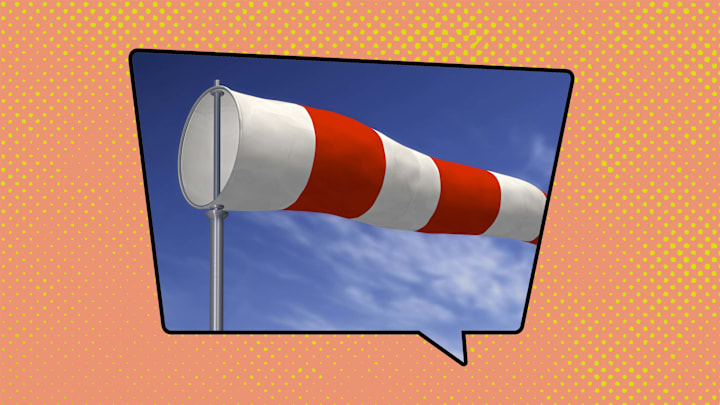Air molecules are always moving around us. When we can feel this movement, we call it wind. If we want to get a little more specific about the windy weather, we can talk about gentle breezes and zephyrs, or forceful gusts and gales—but geographers and climatologists have an additional goody bag full of wonderful wind words that get even more specific about what’s going on with those air molecules and where they’re coming from. Here are 21 names for the wind.
1. Bise
A dry wind from the north or northeast funneled over the Alps into southern France and Switzerland by pressure differences.
2. Mistral
A cold wind that blows over the northwest Mediterranean coast when pressure differences funnel it through the Rhône valley.
3. Bora
A cold, very strong, dry wind on the coast of the Adriatic Sea and northern Italy occurring when pressure is high over the Balkans and low over the Mediterranean.
4. Brickfielder
A summer wind in southeastern Australia that brings hot air from the outback to the cooler regions. Named either for the red dust it used to spread over Sydney from local brickworks, or the fact that it turned the soil as hard as bricks.
5. Southerly Buster

A cold wind from the south that follows the brickfielder.
6. Buran
A strong northeasterly wind in Siberia and Central Asia that is hot in the summer and freezing in the winter. It’s called the purga when it flows over Arctic tundra and the burga in Alaska.
7. Sirocco
A hot, dry, dusty wind that moves air from the Sahara into northern Africa and Italy. Over the Mediterranean it picks up moisture and becomes humid; it is caused by a band of low pressure moving east across the southern Mediterranean.
8. Khamseen
The sirocco in Egypt. It’s the word for 50; the wind is said to blow for 50 days.
9. Gibli
The sirocco in Libya.
10. Xlokk

The sirocco in Malta, pronounced “shlok.”
11. Föhn Wind
A föhn wind draws air up one side of a mountain, where it cools and sheds its moisture as precipitation, and then warms as it compresses coming down the other side of the mountain.
12. Chinook Wind
A wind that carries warmed air down the Rocky Mountains and quickly raises the temperature in the valley below. Cattle grazing depends on it because it melts the snow.
13. Moazagoatl
A Föhn wind that moves over the Sudeten Mountains into Germany and Poland. The term apparently comes from a dialectal version of Matz, the surname of a shepherd who first identified its telltale cloud formation in the mountains.
14. Zonda
A Föhn wind that blows eastward over the Andes in Argentina.
15. Simoom

A hot, whirling wind in the Sahara and Arabian Desert that plays a role in reshaping dunes; it can move vast quantities of sand. From the Arabic for “poison.”
16. Etesians
The annual strong summer winds in the Aegean Sea resulting from a low pressure trough in Asia that is part of monsoon storm systems. Also called meltemi in Greek and Turkish.
17. Shamal
The summer low pressure areas in Asia also cause this northwesterly wind in Iraq that whips up sand and dust.
18. Trade Winds
These winds blow from the northeast in the Northern Hemisphere and the southeast in the Southern Hemisphere toward low pressure regions along the equator. They are reliable enough to plan trade routes around.
19. Tehuantepecer
Strong winds in Central America due to high pressure over North America. They are intensified as they blow through mountain gaps such as the one at the Isthmus of Tehuantepec.
20. Williwaw

A stormy, cold wind that blows down mountains.
21. Willy-Willy
A local whirling wind in Australia that raises small columns of dirt, or dust devils, from the ground.
A version of this story ran in 2014; it has been updated for 2023.
